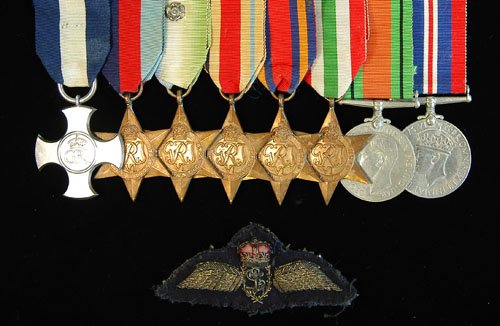
Auction: 6017 - Orders, Decorations, Campaign Medals & Militaria
Lot: 125
A Scarce Second War ´Fleet Air Arm´ D.S.C. Group of Eight Attributed to Wildcat Pilot Lieutenant N.K. Turner, 881 Squadron, Royal Naval Volunteer Reserve, For Shooting Down a HE 177, He Was Later Taken Prisoner of War at Bodo, Norway, 26.4.1944 Distinguished Service Cross, G.VI.R, reverse dated ´1944´ (Hallmarks for London 1942); 1939-1945 Star; Atlantic Star; Africa Star; Burma Star; Italy Star; Defence and War Medals, good very fine or better, with riband bars, Fleet Air Arm Wings, with later letter from recipient with his account of the action, photographs and two original Convoy News summarys recording the action (8) Estimate £ 1,400-1,600D.S.C. London Gazette 30.5.1944 Temp. Sub-Lieutenant Norman Kenneth Turner, RNVR ´For the destruction of two enemy aircraft on 12.2.1944 when providing fighter cover for a Gibraltar-bound convoy´, The Recommendation states, ´On the evening of 12th February, this officer was flown off H.M.S. Pursuer to intercept enemy aircraft approaching the convoy. After a short time, on vector, he sighted the enemy (E.A. Type FW 200), attacked, and set him on fire. The enemy was later seen to crash in flames. Sub-Lieutenant Turner then returned to the ship. This pilot showed no inclination to break off combat to return to the ship until ordered to do so, although the light was failing all the time. He had never landed on a carrier at night. He must have known that in any case he could not be landed on until the attack was over when it would be quite dark. His gallantry and skill contributed to the complete ´break up´ of the enemy attack resulting in the fact that no bombs fell in the convoy and no ships or escorts were damaged.´ Lieutenant Norman Kenneth Monteith Turner, D.S.C., born 1921; enlisted R.N.V.R., 11.11.1940; commissioned Acting Sub-Lieutenant, Royal Naval Reserve, 27.10.1941; posted Pilot 882 Squadron, Fleet Air Arm, 10.3.1942; joined the rest of his squadron in being absorbed into 881 (Canada) Squadron, 1943; the latter joined 7th Naval Fighter Wing, having re-equipped with 12 Wildcat V´s and embarked on H.M.S. Pursuer (Fighter Carrier commissioned in the Royal Navy, June 1943) for Gibraltar Convoys from November 1943-February 1944, including 12.2.1944 (see recommendation), The Convoy News Summary for the action offers more detail, ´Nothing of interest occurred during the night. At dawn the first range was flown off. At 0945, just as relief range had been flown off, Pursuer detected by radar an unidentified aircraft at 45 miles range. Lt. Cdr. Cosh and Lt. Wilson were vectored out towards and "Tally Hoed" at 15 miles from enemy aircraft, which was identified by Lt. Cdr. Cosh as a JU 290. He attacked and scored hits but enemy escaped in clouds. The attack had then to be broken off as this patrol were at the limit of their endurance; one landed on showing six gallons, the other nil. Patrols were maintained during the day, and an air attack was expected, as the JU 290 had obviously sighted and reported. At 1852 four or five plus unidentified aircraft were detected bearing 330 degrees 40 miles. Lt. Cdr. Cosh, Lt. Wilson, Sub Lt. Brander, Sub Lt. Turner were flown off to intercept. The first indication that enemy aircraft had actually closed, from the Bridge; was an escort opening fire on the port beam of us. This aircraft was firing at Lt. Cdr. Cosh, who attacked with no observed result. Another enemy aircraft was then shot down by Sub Lt. Brander and seen to crash on our port side. Giving a quite fair imitation of the Crystal Palace on November 5th. Sub Lt. Turner also attacked and his quarry escaped into cloud on fire. All four Wildcats were landed on safely after dark............. It is now known that the enemy aircraft set on fire by Sub Lt. Turner last night crashed about 10 miles ahead and on the port bow of the convoy. This brings the score up to two certain, one damaged out of a force of four to six enemy aircraft attacking. This may well be the first time that Wildcats have operated after dark, and almost certainly these are the first enemy aircraft shot down by F.A.A. fighters, operating from a carrier after dark. Congratulatory signals have been received from the Commodore, Tavy and Accrington. It is certain that this is the first HE 177 shot down by a F.A.A. aircraft.´ The H.E. 177 was a new bomber at the time with guided bomb systems designed to specifically attack convoys. On 26.4.1944, whilst flying Wildcat JV373, Turner´s aircraft was hit by flak over Armo Island and he was forced to ditch near the beach, 25 yards off the North West tip of Sandhorne Island. He was captured and taken prisoner of war at Bodo, Norway and subsequently imprisoned at Stalag Luft III (Sagan), 10.6.1944-28.1.1945 before being transferred to Stalag Luft III A (Luckenwalde), where he was held 4.2.1945-20.5.1945. He received, ´29 days solitary confinement. The last 5 days was not allowed out of cell to lavatory, but given pot. 5 interviews using the idea that I must establish my identity by giving Sqn. No. etc.´ (M.I.9. Debrief refers).
Sold for
£1,900




